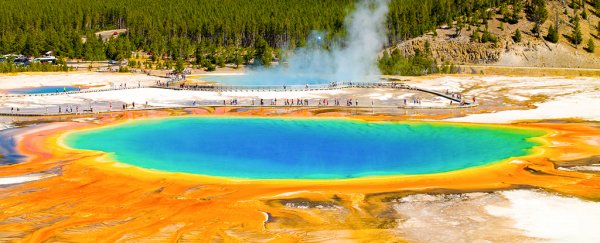The thinking has always been that one giant volcanic eruption created the Yellowstone Caldera or volcanic crater in Yellowstone National Park, Wyoming – but new research suggests we might have been thinking too small.
By studying layers of ash and sediment off the California coast, scientists have been able to find evidence of not one, but two eruptions, a short time apart from each other, happening around 630,000 years ago.
The blasts were so big that they significantly altered the Earth's climate as it was emerging from a major ice age, according to the researchers from the University of California Santa Barbara (UCSB).
"We discovered here that there are two ash-forming super eruptions 170 years apart and each cooled the ocean by about three degrees Celsius [5.4 degrees Fahrenheit]," says one of the team, geologist Jim Kennett.
To understand what created the (now beautiful) 55 kilometre by 72 kilometre (34 mile by 45 mile) caldera, the researchers looked at layers of ash in the Santa Barbara basin matching the chemical footprint of the Yellowstone area.
The geological samples taken from the basin are particularly useful for a number of reasons – one is that at this stage in history, the underwater environment was being fed by nutrients from deep within the ocean.
That gives rise to single-celled organisms called foraminifera, which many researchers use as a marker to show ocean temperature changes through the shells they leave behind. The accuracy of these measurements has recently been questioned, but they still offer a good starting point.
What's more, the researchers found the lack of oxygen down at the bottom of the Santa Barbara basin discouraged the spread of burrowing marine creatures that would have mixed up the layers of ash and shells the geologists have now been relying on.
That left not one but two layers of volcanic ash that could be matched to Yellowstone, sandwiched between organism shells that revealed separate dips in temperature, caused as the ash and volcanic sulfur dioxide blocked out the Sun's light.
One of the unanswered questions is why the cooling periods seem to have lasted longer than would've been expected.
"We see planetary cooling of sufficient magnitude and duration that there had to be other feedbacks involved," says Kennett.
Those feedbacks might include the presence of more sea ice and snow, reflecting the sunlight back, or a bigger change in ocean circulation that caused the cooling to go on for a longer period of time.
And the fact that the world was gradually warming up as these incidents hit was another factor in the researchers' favour.
"It was a fickle, but fortunate time," says Kennett. "If these eruptions had happened during another climate state we may not have detected the climatic consequences because the cooling episodes would not have lasted so long."
The research has been presented at the annual meeting of the Geological Society of America.
